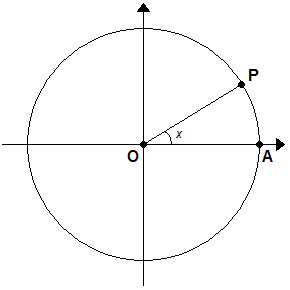Si consideri una circonferenza di raggio

Comunque si fissi
Indice
- Relazione fondamentale della goniometria
- Conversione fra radianti e gradi
- Archi notevoli
- Archi associati
- Relazioni fra funzioni goniometriche di uno stesso arco
- Formule di addizione e di sottrazione
- Formule di duplicazione
- Formule di triplicazione
- Formule di prostaferesi
- Formule di Werner
- Formule di bisezione
- Formule parametriche
- Formule parametriche
Relazione fondamentale della goniometria
Conversione fra radianti e gradi
Se
Archi notevoli
|
[math]x[/math] (radianti) |
[math]x^{circ}[/math] (gradi) |
[math]\\sin (x)[/math] |
[math]\\cos(x)[/math] |
[math]\text{tg}(x)[/math] |
[math]\text{cotg}(x)[/math] |
[math]0[/math] |
[math]0^{circ}[/math]
|
[math]0[/math]
| [math]1[/math]
|
[math]0[/math] | non esiste |
|
[math]frac{\pi}{12}[/math] | [math]15^{circ}[/math]
| [math]frac{\sqrt{6} - \sqrt{2}}{4}[/math]
|
[math]frac{\sqrt{6} + \sqrt{2}}{4}[/math] |
[math]2 - \sqrt{3}[/math] |
[math]2 + \sqrt{3}[/math] |
|
[math]frac{\pi}{10}[/math]
|
[math]18^{circ}[/math]
|
[math]frac{\sqrt{5} - 1}{4}[/math]
|
[math]frac{1}{4} \sqrt{10 + 2 \sqrt{5}}[/math]
|
[math]\sqrt{frac{5 - 2 \sqrt{5}}{5}}[/math]
|
[math]\sqrt{5 + 2 \sqrt{5}}[/math]
|
| [math]frac{\pi}{8}[/math]
|
[math]22^{circ} 30'[/math] |
[math]frac{\sqrt{2 - \sqrt{2}}}{2}[/math] |
[math]frac{\sqrt{2 + \sqrt{2}}}{2}[/math] |
[math]\sqrt{2} - 1[/math] |
[math]\sqrt{2} + 1[/math] |
|
[math]frac{\pi}{6}[/math]
|
[math]30^{circ}[/math]
|
[math]frac{1}{2}[/math]
|
[math]frac{\sqrt{3}}{2}[/math]
|
[math]frac{\sqrt{3}}{3}[/math]
|
[math]\sqrt{3}[/math]
|
|
[math]frac{\pi}{5}[/math]
|
[math]36^{circ}[/math]
|
[math]frac{1}{4} \sqrt{10 - 2 \sqrt{5}}[/math]
|
[math]frac{\sqrt{5} + 1}{4}[/math]
|
[math]\sqrt{5 - 2 \sqrt{5}}[/math]
|
[math]\sqrt{frac{5 + 2 \sqrt{5}}{5}}[/math]
|
|
[math]frac{\pi}{4}[/math]
|
[math]45^{circ}[/math]
|
[math]frac{\sqrt{2}}{2}[/math]
| [math]frac{\sqrt{2}}{2}[/math] |
[math]1[/math]
|
[math]1[/math]
|
|
[math]frac{3 \pi}{10}[/math]
|
[math]54^{circ}[/math]
|
[math]frac{\sqrt{5} + 1}{4}[/math]
|
[math]frac{1}{4} \sqrt{10 - 2 \sqrt{5}}[/math]
|
[math]\sqrt{frac{5 + 2 \sqrt{5}}{5}}[/math]
|
[math]\sqrt{5 - 2 \sqrt{5}}[/math]
|
|
[math]frac{\pi}{3}[/math]
|
[math]60^{circ}[/math]
|
[math]frac{\sqrt{3}}{2}[/math]
|
[math]frac{1}{2}[/math]
|
[math]\sqrt{3}[/math]
|
[math]frac{\sqrt{3}}{3}[/math]
|
| [math]frac{3 \pi}{8}[/math]
|
[math]67^{circ} 30'[/math] | [math]frac{\sqrt{2 + \sqrt{2}}}{2}[/math]
|
[math]frac{\sqrt{2 - \sqrt{2}}}{2}[/math] |
[math]\sqrt{2} + 1[/math] |
[math]\sqrt{2} - 1[/math] |
|
[math]frac{2 \pi}{5}[/math]
|
[math]72^{circ}[/math]
|
[math]frac{1}{4} \sqrt{10 + 2 \sqrt{5}}[/math]
|
[math]frac{\sqrt{5} - 1}{4}[/math]
|
[math]\sqrt{5 + 2 \sqrt{5}}[/math]
|
[math]\sqrt{frac{5 - 2 \sqrt{5}}{5}}[/math]
|
| [math]frac{5 \pi}{12}[/math]
|
[math]75^{circ}[/math] |
[math]frac{\sqrt{6} + \sqrt{2}}{4}[/math] | [math]frac{\sqrt{6} - \sqrt{2}}{4}[/math]
| [math]2 + \sqrt{3}[/math]
|
[math]2 - \sqrt{3}[/math] |
|
[math]frac{\pi}{2}[/math]
|
[math]90^{circ}[/math]
| [math]1[/math]
|
[math]0[/math]
| non esiste |
[math]0[/math]
|
Archi associati
Si possono ricavare i valori di seno, coseno, e delle altre funzioni goniometriche relativamente ad altri angoli notevoli mediante le formule seguenti
|
[math]\\cos(\pi + x) = - \\cos(x)[/math]
|
[math]\\sin (\pi + x) = - \\sin(x)[/math] |
[math]\text{tg}(\pi + x) = \text{tg}(x)[/math] |
|
[math]\\cos(\pi - x) = - \\cos(x)[/math]
|
[math]\\sin (\pi - x) = \\sin(x)[/math] |
[math]\text{tg}(\pi - x) = - \text{tg}(x)[/math] |
|
[math]\\cos(frac{\pi}{2} + x) = - \\sin (x)[/math]
|
[math]\\sin (frac{\pi}{2} + x) = \\cos(x)[/math] |
[math]\text{tg}(frac{\pi}{2} + x) = - \text{cotg}(x)[/math] |
|
[math]\\cos(frac{\pi}{2} - x) = \\sin (x)[/math]
|
[math]\\sin (frac{\pi}{2} - x) = \\cos(x)[/math] |
[math]\text{tg}(frac{\pi}{2} - x) = \text{cotg}(x)[/math] |
|
[math]\\cos(-x) = \\cos(x)[/math] |
[math]\\sin (-x) = - \\sin(x)[/math] |
[math]\text{tg}(-x) = - \text{tg}(x)[/math] |
Relazioni fra funzioni goniometriche di uno stesso arco
Formule di addizione e di sottrazione
Formule di duplicazione
Formule di triplicazione
Formule di prostaferesi
Formule di Werner
Formule di bisezione
Formule parametriche
Formule parametriche








 Accedi a tutti gli appunti
Accedi a tutti gli appunti
 Tutor AI: studia meglio e in meno tempo
Tutor AI: studia meglio e in meno tempo